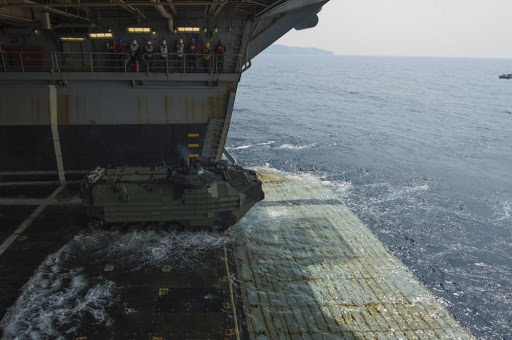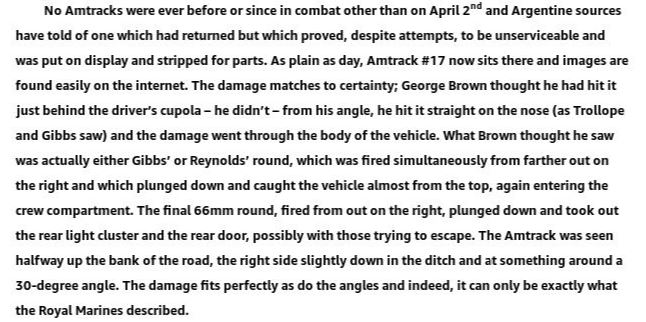LVTP-7: Intro
A brief description of the LVTP-7 amphibious APC, their use in the Argentine Navy, their role in Operación Rosario and the combat episode in the outskirts of Stanley, showing the points where the Royal Marines claim they hit the vehicle.
The LVTP-7 Amphibian APC
The LVTP-7 case is a bit more complex, because there’s a lot of factors to
cover. Argentina never denied their role in the landing, nor denies their
combat episode in White City. What Argentina denies it’s that VAO #17 (Vehículo
Anfibio a Oruga, Tracked Amphibian Vehicle) was part of the landing team and
that it was destroyed with all crew onboard.
The Argentine LVTP-7s were from the first version manufactured by FMC, the
hull is made entirely of aluminium alloy to save weight and help flotation, the
armor is 45 mm at the front, and 31-35 mm on the sides. Is powered by a Cummins
400 HP engine, armament consisted of a 12.7 mm (.50 cal) M2 machinegun (not 30 mm. as disclosed in The First Casualty), had
night vision systems, and carried up to 25 passengers, plus a crew of three:
Commander, Driver, and Gunner.
The Argentine LVTP-7s
Between 1973 and 1974, Argentine Navy bought 21 LVTP-7s, 19 assault
vehicles, named VAO 01 through VAO 19, one command vehicle, VAO C1, and the
recovery vehicle, VAO R1. The vehicles had a hard time operating with the old
WWII Landing Ships, ARA Cándido de Lasala (retired in 1981) and ARA Cabo San
Antonio, the steep and narrow ramp, added to the rolling movement of the ships
put a heavy strain to their hulls, some developing hull fissures or axis
displacements. By the end of 1981, many of them were out of order, and were put
back in service with spare parts brought from the US, once the Carter
administration embargo finished. In fact, it’s not so suspicious that the VAO
17 was the only one that couldn’t make it to the landing, it’s remarkable that
they could put so many back in service. By March 19, two weeks before the
landing, only 12 vehicles were ready for the exercise in San Román beach.
The combat at White City
The landing party was launched from ARA Cabo
San Antonio at 6:15 AM and 15 minutes later, they landed at Red Beach, north of
the airport. After capturing it, a leading team of three Amtracs proceeded to
Stanley with the instructions to link up with the Amphibian Commandos in Moody
Brook barracks. These vehicles were VAO 7, VAO 19 and VAO 5, under Cpn.Santillán command. Around 7:15 AM they reached Stanley’s outskirts, when fire
erupted from a group of recently built houses called White City by the locals,
near the Ionospheric Station. In The First Casualty is published a scheme of
the combat, but it’s not very accurate, must be taken more as a diagram rather
than an actual map of the location:
In reality, the curves of the Airport Road
were much gentler, the APCs were facing the Marines in a shallow angle:
Currently, that part of Stanley looks more
developed, but the general disposition of the road is pretty much the same, I
drew a 250 m. long line, to give a sense of scale and an approximate idea of
the maximum range of engagement:
I also made a 3D reconstruction of White City,
based on all this visual evidence. Of course, it’s an schematic reconstruction:
Impact Points
According to Phillips, this is how Lt.
Trollope’s section engaged and damaged the Amtrac (The First Casualty
(2017), Appendix 2: The Battle on the Airport Road):
This VAO #17 is currently in the Monument to
the Fallen in Quequén, Buenos Aires Province, around 500 Km. South of Buenos
Aires City:
In the following articles, I will analyze these three impact points and elucidate their nature.
LVTP-7 Cupola:
Using exclusive pictures of VAO #17, the vehicle Phillips claims was destroyed by the Royal Marines, this article demonstrates that the hole behind the cupola is the mounting point of a removed auxiliary vision periscope.
LVTP-7 Rear Light:
An analysis of the impossibility to impact the rear light from the RM positions in such a bizarre trajectory, more pictures and videos reveals that there's no sign of battle damage in the rear area; and that the rear light used as evidence by Phillips is a falsification.
LVTP-7 Nose Patch:
More pictures and videos showing that the internal damage is not compatible with Phillips theory, the impossibility to affect the crew compartment even accepting the damage was caused by a HEAT impact, and pictures of the vehicle from 1986-87 showing no damage in that area.
Next: LVTP-7: Cupola























